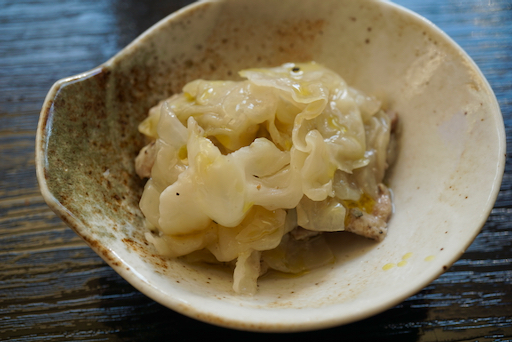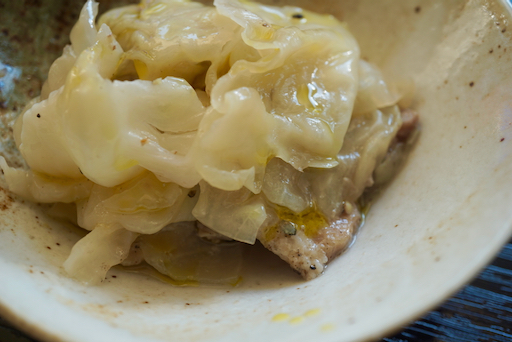Although we can get ”pork belly” or "Sanmai-niku" 三枚肉 (meaning "three layer meat" referring to alternating layers of fat and red meat) at specialty grocery stores such as Whole Foods, it has not been available at our usual grocery store. But the other day, I found a large package of pork belly (probably 2-3 lb). I could not resist getting one. It was rather large and I made "
Kakuni" 角煮 from half and made pork belly
chasu 三枚肉チャーシュー from the other half. Since this is usually served as a ramen topping, I made miso ramen with pork belly chasu as a lunch one weekend.
I also made "ajitama" 味玉 or seasoned soft boiled egg. I also opened a jar of store-bought "Menma" メンマ seasoned bamboo shoot. I added nori seaweed and finely chopped chives as toppings.
As before, the ramen noodle is
American-made frozen ones from "
Sun Noodle". I also used "miso" seasoning that came with the noodles but instead of hot water, I used Japanese broth made from a "
dashi pack" to make the soup.
Pork Belly chasu
Ingredients:
1 lb pork belly (half of the piece of pork I got), thinner portion (I assume this is towards the front) which I rolled tightly and trussed.
3 tbs soy sauce
1 tbs mirin
1 tbs sake
1 scallion, bruised with back of the knife
2 cloves garlic, crushed and skin removed
5 black pepper corns
3 star anises (optional)
Water to cover
Directions:
Place the pork in a pot (in which the pork snuggly fits), add the soy sauce, mirin, sake, scallion, garlic, black pepper corns, and star anise. Marinate for a few hours at room temperature turning a few times.
Add water so that the pork is just barely covered. Cover the pork with either a silicon "
otoshi buta" 落し蓋 or aluminum foil.
Put on the lid and simmer for several hours turning a few times.
Let it cool in the simmering liquid and then put into the refrigerator for overnight.
Skim off fat.
To serve:
Remove the pork from the now congealed marinade (#1 and #2).
Slice it to 1/4 to 1/2 inch thick (#3)
Meanwhile, soft boiled egg was marinated in Japanese concentrated noodle sauce in a Ziploc bag for overnight or longer in the refrigerator (#4).
Cut the egg in half (#5). After 24 hours, the yolk is still liquid but the more you marinate, the more yolks will jell.
I have "pork belly chasu", "menma" seasoned bamboo shoots, "ajitma" seasoned boiled egg and chopped chives for toppings (#6).
I boiled one serving of the ramen noodle as per the instructions and drained (this is half ramen 半ラーメンfor each of us).
Divide the miso seasoning package into two portions and place it in the bowls. Pour in hot dashi broth and dissolve the miso seasoning.
Add half of the package of noodles into each bowl.
Garnished it with the toppings above and the nori sheet.
This was rather decadent ramen. Compared to pork loin or even shoulder version of chasu, this is much more unctuous. On other occasion, I made "
chasu and egg" チャーシューエッグ using this which was also really good. We have to be careful that all this lovely pork belly will be "too much of a good thing"...Not likely!




















































